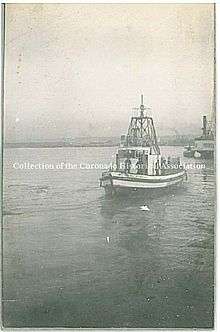Fireboats of San Diego

Fireboats in San Diego have been operated on San Diego Bay and at the Port of San Diego by the city of San Diego, California since the early 20th century.
Port of San Diego
The port's first fireboat, the Bill Kettner, was named after San Diego's Congressional Representatives William Kettner. [2] The vessel was built by the city's own firefighters in their own workshop.[3] It was commissioned in 1919.
The Point Loma II a small patrol vessel, with a modest pumping capacity, served from 1957 to 1977.[2] She had a single water cannon, only capable of pumping 1,200 gallons per hour.[4]
The Bill Kettner was retired in 1961, when she was replaced by the Shelter Island.[2] The Shelter Island had a two water cannon, capable of pumping 2,000 gallons per minute and 1,000 gallons per minute.[4]
A third vessel, the Harbor Island was also put into service.[4] She had a single water cannon, capable of pumping 2000 gallons per minute.
San Diego Harbor Police
The San Diego Harbor Police has an area of responsibility that includes the San Diego Bay shorelines of the cities of San Diego, National City, Chula Vista, Imperial Beach, and Coronada.
On November 22, 2010 the city accepted 2 new fireboats, to be operated by the San Diego Harbor Police, that were paid for by a Port security grant from the federal Department of Homeland Security. [5][6] The two new vessels each have three water cannon. They replaced three older and less capable vessels, that had been in service for 35 years.
In 2011 the City of San Diego agreed to accept an additional three more vessels, under another grant from the Department of Homeland Security.
San Diego Lifeguard Department
On June 26, 2015, a new high speed vessel christened the Marine 3 began operation by the San Diego Lifeguard Department.[7] The vessel is equipped for both search and rescue and firefighting duties. It is equipped with infrared and other sensors, for helping to find missing sailors and lost boats. The two water cannon, each capable of pumping 12,000 gallons per minute, can be remotely controlled from the cabin. The lifeguard department's previous rescue and fire vessel had just a single water cannon, capable of pumping only 500 gallons per minute. The vessel cost $1 million, and its projected life is 25 years.
See also
- Fireboats of California
- Fireboats of the United States
References
- ↑ "Department History". San Diego Fire-Rescue Department. Retrieved 2015-06-28.
In 1919, the San Diego Fire Department christened the first gasoline powered fire boat in the world. The boat, the "Bill Kettner" was built from the keel up at the San Diego Fire Department shop, by firefighters.
- 1 2 3 Michael P. Rich (2014). "San Diego Harbor Police". Arcadia Publishing. ISBN 9781439648520. Retrieved 2015-06-27.
- ↑ Peter Corona (2009). Little Italy: the way it was. Trafford Publishing. pp. 107, 202. ISBN 9781426988004. Retrieved 2015-06-27.
As a child, I remember seeing the 59-foot fireboat Bill Kettner operating in San Diego harbor. On one occasion I saw the fireboat crew shooting water up toward the sky. It was a beautiful sight.
- 1 2 3 "Naval Base San Diego (NBSB) Information handbook" (PDF). United States Navy. 2012-04-21. Retrieved 2015-06-27.
- ↑ "New Vessels Boost Ability To Fight Fires On The Bay". KGTV. 2010-11-22. Retrieved 2015-06-27.
When compared to the boats in use for the past 35 years, the newer vessels can shoot water farther and out of three cannons instead of just one.
- ↑ R Stickney (2013-12-16). "Fire Destroys Yacht on Harbor Island". NBC San Diego. Retrieved 2015-06-27.
Two San Diego Harbor Police boats used water cannons and foam to extinguish the fire around 12:30 p.m. Monday.
- ↑ Ashley Jacobs (2015-06-26). "New fire boat gives San Diego lifeguards advantage". KFMB. Retrieved 2015-06-27.
Several local leaders gathered Friday to christen Marine 3, which is a lifeguard fire boat. It will be used for many jobs, including rescue missions and support in fighting fires.